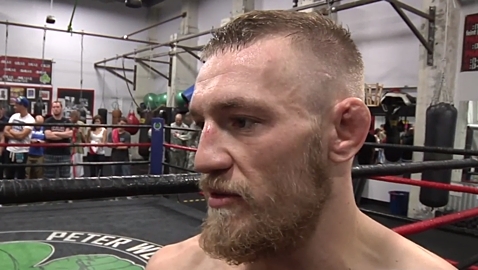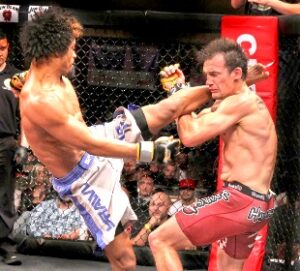
If you’re a newcomer to the UFC, you may be wondering about the weird ears many UFC fighters have. This disfigurement is known as cauliflower ear, resembling the vegetable.
In this article, we’ll look at what it is, the causes, prevention, and the treatment of cauliflower ears.
Contents
The Science Behind Cauliflower Ear – What Is It and How Is It Formed?
The medical term for cauliflower ear is a perichondrial hematoma and it applies only to the external part of the ear. Through constant friction and trauma of the ears, vessels swell and blood clots form under the perichondrium; a layer of fibrous connective tissue covering the cartilage of the ear.
The blood clots form a blockage and separation between the perichondrium and the cartilage, resulting in the cartilage being unable to receive the nutrients it needs through normal blood flow.
This leads to the tissue being damaged and the death of cartilage. This then causes a cascade of new cartilage being laid down, which fibrosis contracts, leading to deformity of the ear.
Fibrosis is the process of normal connective tissue being replaced and remodeled by the formation of new scar tissue, which is hard, lumpy, and resembles a cauliflower.
Why Do UFC Fighters Have Weird Ears? (The Causes)
Fighting and the constant trauma the ears endure cause cauliflower ear. Most believe strikes to the ears are the cause of cauliflower ear because of the severity of the injury many fighters sustain; such as a split or heavily bleeding ear.
Instead, wrestling is the main culprit of cauliflower ear among UFC athletes, which is why the disfigurement is also known as wrestler’s ear. Wrestling is to blame due to the constant rubbing and friction of the ears against an opponent.
Fighters are not aiming to punch someone’s ear, so damage to the ears through striking is more uncommon than the trauma caused by intense and close-up grappling and wrestling.
With wrestling being such a dominant aspect of a UFC fighter’s success, cauliflower ears are prevalent among the UFC’s roster. The majority of fighters who began as wrestlers have at least mild cauliflower ears, and strong wrestling skills are required to get into the UFC.
However, cauliflower ear is not entirely caused by wrestling. Any martial arts causing trauma to the ear will contribute to the formation of cauliflower ear.
Here are the main martial arts that cause UFC fighters’ ears to get injured:
Wrestling – The most common cause of cauliflower ear, wrestlers have a low stance and are engaging head first so they’re rubbing and bashing their ears against one another often when battling for head control and position.
Bjj – Much like wrestling, in jiu-jistu, UFC fighters’ ears rub on the mat and on their opponent a lot because of the grappling, chokes, and scrambles on the ground.
Muay Thai – The most likely combat sport to cause trauma and cuts to the ears because of the use of knees and elbows – they’re very sharp and can cut and damage ears easily. Also, a lot of the high kicks and elbows target the side of the head, so the ears receive a lot of punishment.
Kickboxing – Similar to muay thai and boxing, kickboxing is more likely to cause cauliflower ear because of the heavy kicks to the ears and the number of strikes to the side of the head.
Is cauliflower Ear Preventable for UFC Fighters?
Short answer: There are UFC fighters without cauliflower ears, so, yes, cauliflower ear is preventable. Is it likely? Not at all. The majority of UFC fighters’ ears have deformities and if they don’t have them now, odds are they will have them eventually. Prevention is largely down to genetic factors, rather than any actionable measures.
Prevention Through Headgear
The most important and only real way to prevent cauliflower ear is through wearing headgear, most usually an ear guard. It’s important to have a perfect size because overly tight headgear can cause friction and rubbing just as bad as the rubbing experienced without headgear, and if the headgear is loose, it doesn’t offer much protection against strikes.
Most gyms require headgear in their MMA classes for training and sparring, but headgear is not permitted in fights. This makes cauliflower ear harder to prevent due to the number of fights without headgear, and many have been fighting for years before they make it to the UFC.
Most UFC fighters won’t use headgear when training or sparring, finding headgear uncomfortable as you need to wear it tightly so they don’t move during grappling exchanges or when being struck.
Also, the headgear may hinder vision, block hearing, make breathing harder, and increase sweat build-up inside. Not only that, but UFC fighters want their training sessions to mimic upcoming fights.
Daron Cruickshank, a former UFC lightweight known for his 13 fights in the UFC, said about cauliflower ear, ‘I developed mine in high school, even though I wore my headgear’. So even if you use the most important defense against cauliflower ear, there’s still a chance of developing disfiguration.
This means preventing cauliflower ear is likely to be down to avoiding heavy damage from strikes, and more importantly the avoidance of friction from grappling and wrestling. Avoiding either is unlikely considering the nature of MMA and its huge incorporation of wrestling, muay thai, and Bjj.
Prevention Through Treatment
Fighters can attempt to prevent cauliflower ear through early treatment as cartilage death occurs roughly 6 hours after trauma, leaving the damage permanent.
Here are the main symptoms arising before cauliflower ears are formed:
- Ringing in the ear (tinnitus) or hearing loss
- Headaches or blurred vision
- Bleeding from the ear
- Cuts, bruises, or swelling of the ear
- Pain
Ears should always be checked after a fight or training session to check for any of these symptoms. Fighters that have injured their ears and have symptoms like bruising, swelling, or pain, should ice them immediately after the fight at 15-minute intervals every hour until the swelling has reduced.
If the damage is bad and swelling hasn’t reduced (or any other symptom), a doctor should assess it and give immediate medical treatment.
Most often ears will be swollen, so the doctor will make an incision and drain all pooled blood from the ear. To aid healing, a compression dressing will be applied and antibiotics prescribed to prevent infection.
Depending on the injury and doctor, magnets may be used under the dressing as they help compress the ear and prevent the pooling of blood. They require the fighter to move them up and down to damaged parts of the ear after every few hours, until the ears have healed, usually after 3-7 days.
The doctor will usually give the best information on the healing process as it’ll be slightly different for each kind of injury.
Despite blood being drained and the cartilage receiving nutrients as normal, perfect function and recovery are not guaranteed as blood can re-form in the ear.
If blood accumulates, the treatment process will be repeated until the ear heals or there’s a formation of scar tissue. Again, as good as the treatment is, it’s largely genetics that determines how well the ear heals.
Prevention Through Time off and Mentality Changes
If damage to the ear has occurred and treatment has been administered, fighters should allow for their ear to recover; which is usually a few days to a week, and sometimes up to two weeks.
However, many fighters have strict training schedules and upcoming fights, meaning they don’t give their ears time to fully heal by avoiding infections and further trauma.
Fighters are unlikely to take a long time off training to let their ear heal, knowing injuries and irritation of the ear are so frequent, that it’s likely to reoccur. Those having frequent ear trauma or injuries eventually accept their fate and adopt the mentality that cauliflower ear is unpreventable.
Former UFC fighter, Tom Lawlor, said about cauliflower ear, “you can drain it right away, and it will be fine…Of course, that’s if you do nothing afterward. But no one does nothing afterward and lets it heal. You go train right away, and the next day it’s going to be an issue all over again. But I don’t have to drain them anymore. There’s nowhere left for any cauliflower to grow.”
This shows how the prevention of cauliflower ears among UFC fighters can come down to their beliefs and mentality toward disfigurement. If a fighter were to take time off and let their ear heal, it would increase their chances of preventing cauliflower ear, but they rarely do so.
All UFC fighters know the risks of MMA and have readily accepted the dangers and drawbacks, in order to push forward.
Their love for the sport, and the striving to be better and earn more income, make them forget about cauliflower ear altogether – and when asked about it, many act prideful of their scars and wear them as a badge of honor.
Ultimately, UFC fighters’ prevention of cauliflower ear is largely determined by whether they’re genetically predisposed to form scars after the tissue and cartilage have been damaged or have died.
Any fighter late into their UFC career that hasn’t at some point had cauliflower ear, is not genetically predisposed to hematomas or the formation of scar tissue.
UFC Fighters’ Ears (Is Cauliflower Ear Permanent?)
Cauliflower ear is permanent, as once the cartilage has been damaged and has died, it cannot be repaired. However, cauliflower ear can be treated and improved through otoplasty.
Otoplasty is a corrective surgery used to reverse the appearance of cauliflower ears. The surgery consists of a cut being made at the back of the ear to expose the cartilage, the removal of the dead cartilage, and the ear being stitched back up.
This improves the look of the ear, but there are no guarantees the ear will look as it did before the appearance of the cauliflower ear.
Many UFC fighters use otoplasty at the end of their career, rather than midway when they’re expecting more fights. Due to the nature of the UFC, reinjury and trauma to the ears are likely to reoccur; so the surgery’s seen as a waste of time and money for anyone still fighting.
Also, recovery from otoplasty surgery is set to a minimum of four weeks, in which no physical activity can take place. This would disrupt a UFC fighter’s training regimen and/or preparation for a fight.
Cases of Damaged Ears Prematurely Ending MMA Fights
Although hard to prevent, fighters need to always be aware of their ear health, as ears full of blood can pop during a fight and cause a fighter to lose via a doctor stoppage. Below are some examples:
- Leslie Smith (UFC 180) – Her ear popped mid-fight and the huge amount of blood caused her to lose via doctor stoppage.
- Sakuraba (Dynamite 2010) – His ear popped and bled, before being nearly torn off after his opponent snuffed a takedown. The fight ended via doctor stoppage.
- James Thompson (EliteXC 2008) – His ear exploded after strikes from Kimbo Slice. The bout was ended via doctor stoppage due to the amount of blood, giving Kimbo Slice the TKO victory.
To Conclude
UFC fighters’ ears being deformed is part and parcel of martial arts, but they can try their best in avoiding cauliflower ears by wearing headgear whenever possible and being quick and diligent with their ear treatment and recovery.
However, it’s not a given that cauliflower ear can be prevented, as the trauma of the ear is unavoidable in the UFC, and cauliflower ear formation mostly comes down to genetic factors.
Most UFC fighters live with their disfigurement and are prideful of them until they have them surgically improved through otoplasty at the end of their career.




